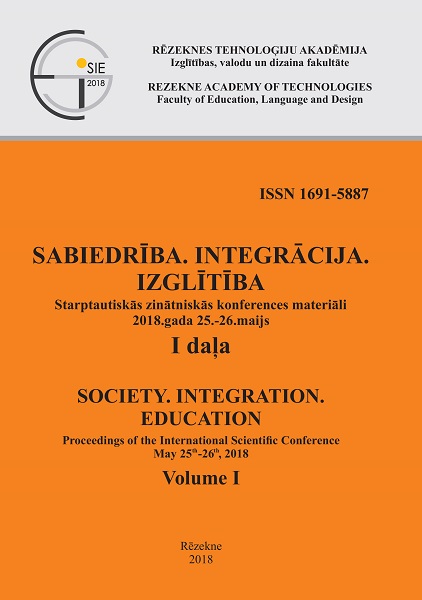INTERDISCIPLINARY INTEGRATION ON THE BASIS OF THE GEOMETRICAL CONSTITUENT OF THE NATURAL SCIENTIFIC PICTURE OF THE WORLD
DOI:
https://doi.org/10.17770/sie2018vol1.3225Keywords:
teaching students, interdisciplinary integration, spatial representations, geometrical component of the natural-science picture of the worldAbstract
Fragmentariness of the picture of the world in majority modern students is a significant obstacle in the development of their scientific worldview. The lack of integrity of the image of the universe is aggravated by the prevalence of the clip-on thinking among students, which prevents the students from fully acquiring fundamental classical education. The formation of an integral scientific picture of the world is necessary for the realization of an in-dependent productive research activity. In whatever field this activity is carried out, it is closely related to the creation of spatial representations and the mental manipulation of them in the process of solving various problems. Spatial representations are ordered in the mind of the learner on the basis of the geometric component of the natural science picture of the world. Integrated content courses such as "Introduction to the Modern Geometry of the Universe" while teaching of students should be combined with the implementation of the principle of interdisciplinary integration in the development of the educational program, carried out on the basis of the geometric component of the natural-science picture of the world.
References
Vytuleva K. (2009). Iced Architects. European architectural history network, 3, 38-41.
Гусев, В. А., & Докшукин, З. П. (2012). Новая стратегия обучения геометрии в основной школе. Педагогическое образование и наука, 3, 22-25.
Дуцев, М. В. (2013). Концепция «полей» художественной интеграции в новейшей архитектуре. Вестник Московского государственного строительного университета, 2, 22-28.
Ермак, Е. А. (1991). Развитие пространственных представлений старшеклассников при изучении геометрии с использованием элементов неевклидовых геометрий. Автореферат диссертации на соискание учёной степени кандидата педагогических наук. Санкт-Петербург.
Ермак, Е. А. (2003). Развитие геометрической составляющей естественнонаучной картины мира старшеклассников. Известия Российского государственного педагогического университета имени А.И.Герцена, 3 (6), 204-214.
Ермак, Е. А. (2005). Геометрическая составляющая естественнонаучной картины мира старшеклассников. Диссертация на соискание учёной степени доктора педагогических наук. Санкт-Петербург.
Ермак, Е. А. (2013). О подготовке магистрантов к деятельности по развитию пространственного мышления обучающихся. Вестник Псковского государственного университета. Серия «Естественные и физико-математические науки». Выпуск 3, 100-103.
Подходова, Н. С. (2017). Психолого-педагогические аспекты методического наследия Лобачевского: актуальность и значимость. Н.И. Лобачевский и математическое образование в России. Материалы Международного форума по математическому образованию, посвящённого 225-летию Н. И. Лобачевского (Казань, 18-22 октября 2017 г.). 1, 28-36. Retrieved from http://dspace.kpfu.ru/xmlui/bitstream/handle/net/117676/F_IFME_2017_1_28_36.pdf?sequence=-1&isAllowed=y.
Якиманская, И. С., & Карымова, О. С. (2009). Семантический психогеометрический тест. Оренбург: Оренбургский государственный университет.






